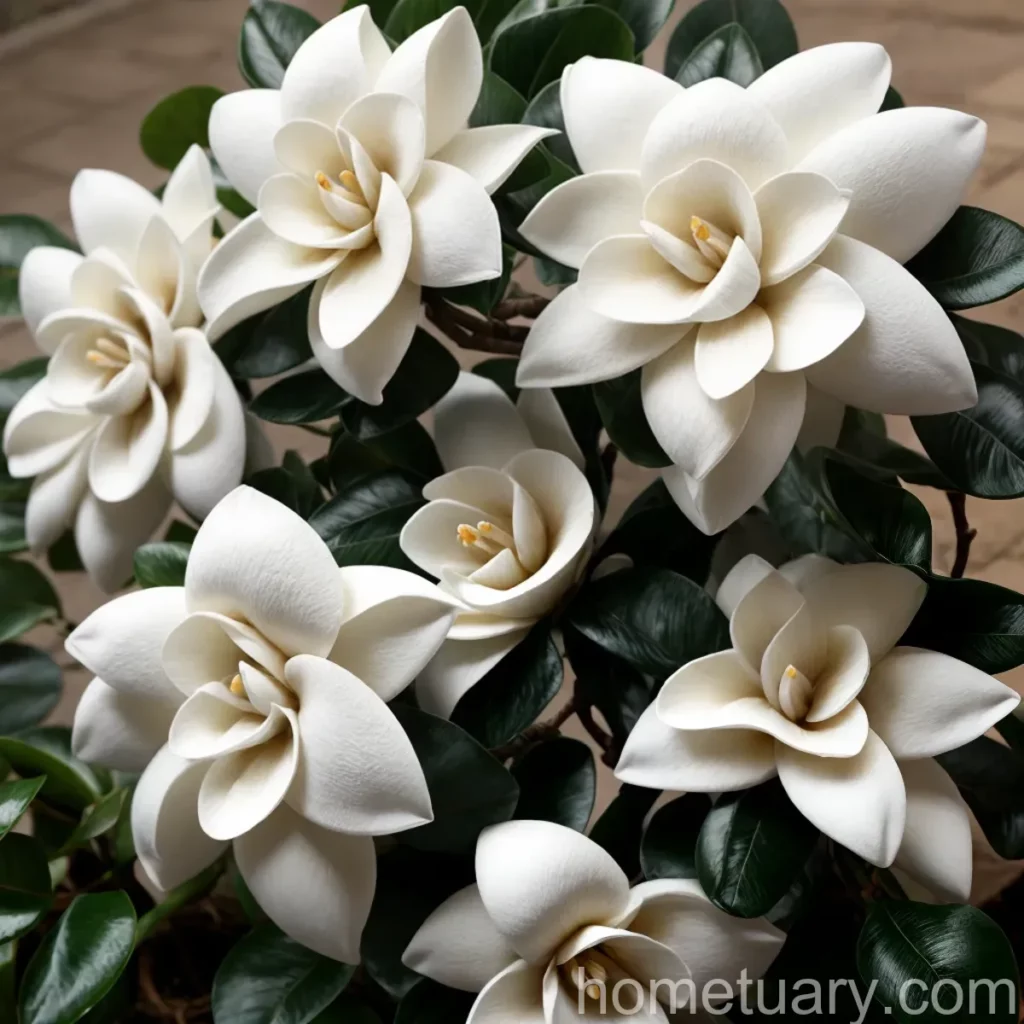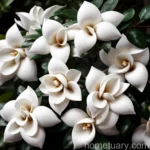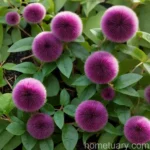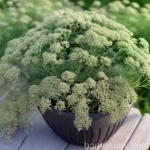Gardenia Plant Care: Everything You Need to Know
Gardenias (Gardenia jasminoides) are known for their intoxicating fragrance and exquisite beauty. These plants have been cherished for centuries and continue to be a popular choice for gardens, landscapes, and indoor settings. In this comprehensive guide, we will delve into the world of gardenia plant care, covering everything from cultivation and maintenance to common diseases and pests. Whether you are a seasoned gardener or a novice plant enthusiast, this article will equip you with the knowledge needed to cultivate healthy and thriving gardenias.
What is Gardenia (Gardenia jasminoides)?
Gardenia jasminoides, commonly known as gardenia, cape jasmine, or common gardenia, is a species of flowering plant in the coffee family, Rubiaceae. Native to Asia, gardenias are renowned for their glossy, deep green foliage and fragrant, creamy white flowers. These evergreen shrubs are treasured for their ornamental value and are often cultivated for their captivating scent, making them a popular choice for gardens, hedges, and indoor decorative purposes.
Key Takeaways – Gardenia (Gardenia jasminoides)
Before delving into the specifics of gardenia plant care, here are some key takeaways that capture the essence of cultivating and maintaining gardenias:
- Gardenias are prized for their fragrant, creamy white flowers and dark green foliage.
- They require well-draining, acidic soil and thrive in warm, humid environments.
- Adequate watering and regular fertilization are essential for the healthy growth of gardenias.
- Pruning is crucial to maintain the desired shape and promote flowering.
- Gardenias can be propagated through stem cuttings and air layering.
- Common diseases and pests that affect gardenias include sooty mold, aphids, and whiteflies.
- Gardenias are popular choices for containers and can be grown indoors with proper care.
Now that we have established an overview of gardenias, let’s delve into the specific aspects of gardening care for these captivating plants.
Culture
Uses
Gardenias are versatile plants that offer a range of uses, both ornamental and practical:
-
Ornamental Purposes: The exquisite flowers and glossy foliage of gardenias contribute to their appeal as ornamental plants, often used as focal points in gardens, borders, and landscapes.
-
Fragrance Production: The flowers of gardenias are used in the production of perfumes, essential oils, and scented candles due to their captivating aroma.
-
Indoor Decor: Cut gardenia flowers are often used in floral arrangements and bouquets, adding elegance and fragrance to indoor spaces.
-
Traditional Medicine: In some cultures, gardenia extracts are used in traditional medicine for their purported medicinal properties.
-
Symbolism: The symbolic meaning of gardenias varies across cultures, often representing love, purity, and refinement.
Water
Proper watering is fundamental to the health and vitality of gardenias. These plants thrive in moist but well-draining soil, and maintaining adequate soil moisture is essential, especially during the growing season. However, it’s crucial to avoid waterlogged conditions, as excessive moisture can lead to root rot and other issues.
-
Regular Watering: Gardenias should be watered regularly, especially during dry periods, to ensure that the soil remains consistently moist. A 1-2 inch layer of mulch can help retain soil moisture.
-
Avoid Overhead Watering: When watering gardenias, it is best to avoid wetting the foliage, as this can increase the likelihood of fungal diseases. Watering at the base of the plant is recommended.
-
Use Soft Water: If your tap water is hard or high in alkalinity, consider using rainwater or distilled water for watering gardenias, as they prefer slightly acidic soil conditions.
Sunlight
Gardenias thrive in bright, indirect sunlight and benefit from partial shade, especially during the hottest parts of the day. Adequate light is essential for promoting flowering and maintaining the overall health of the plant.
-
Morning Sun: Gardenias appreciate morning sunlight, which is gentler and less intense. Morning sun exposure helps to stimulate flowering while reducing the risk of scorching the foliage.
-
Afternoon Shade: Providing gardenias with afternoon shade can protect them from the harsh, direct sunlight, especially in regions with hot summers.
-
Indoor Lighting: When grown indoors, gardenias should be placed in locations with bright, indirect light, such as near east or west-facing windows.
Fertilizer
Fertilizing gardenias is integral to ensuring robust growth, vibrant foliage, and prolific flowering. These plants have specific nutrient requirements, and addressing them through appropriate fertilization is essential for their overall health and vitality.
-
Acidic Fertilizer: Gardenias prefer acidic fertilizer formulations designed for acid-loving plants. These fertilizers help maintain the pH of the soil and provide essential nutrients.
-
Frequency: During the growing season, gardenias benefit from regular fertilization. A balanced, slow-release fertilizer can be applied every 4-6 weeks to provide the necessary nutrients for healthy growth and flowering.
-
Avoid Excess Nitrogen: While gardenias require nitrogen for growth, excessive nitrogen can promote lush foliage at the expense of flowers. Look for fertilizers with a lower nitrogen content to encourage balanced growth.
Soil
The soil requirements for gardenias are quite specific, and providing the right growing medium is crucial for their well-being. Gardenias thrive in acidic, well-draining soil with good fertility, and the soil pH plays a significant role in their overall health and performance.
-
Acidic Soil: Gardenias prefer soil with a pH between 5.0 and 6.0. It is essential to ensure that the soil is acidic to support the uptake of essential nutrients.
-
Organic Matter: Amending the soil with organic matter such as peat moss, compost, or well-rotted manure can improve its texture and fertility, providing an optimal growing medium for gardenias.
-
Well-Draining: Gardenias are sensitive to waterlogged conditions, so it is crucial to ensure that the soil provides good drainage. Adding perlite or coarse sand to the soil mix can enhance drainage.
Pruning
Proper pruning is essential for maintaining the shape, size, and health of gardenias. Pruning also encourages branching and stimulates flower production, leading to a more compact and floriferous plant.
-
Timing: The best time to prune gardenias is after they have finished flowering, typically in late spring or early summer. This allows the plant to recover and set buds for the next flowering season.
-
Deadheading: Removing spent flowers promptly not only enhances the plant’s appearance but also encourages the development of new flower buds.
-
Thinning and Shaping: Regular pruning can involve thinning out crowded branches and shaping the plant to maintain an attractive and balanced form.
Propagation
Propagating gardenias allows gardeners to create new plants from existing ones, whether to expand their garden or share these beautiful plants with others. Gardenias can be propagated through stem cuttings or air layering.
-
Stem Cuttings: This method involves taking 4-6 inch cuttings from healthy, vigorous stems and rooting them in a suitable growing medium. The use of a rooting hormone can enhance the success of propagation.
-
Air Layering: Air layering is another effective method of propagating gardenias. This technique involves creating a wound on a healthy stem, enclosing it with damp moss or a similar medium, and allowing roots to form before separating the new plant from the parent.
Container Popularity
Gardenias are popular choices for container gardening, allowing enthusiasts to enjoy these beautiful plants in a variety of settings, including patios, balconies, and indoor spaces. When grown in containers, gardenias require special attention to ensure their specific needs are met.
-
Container Selection: Choose a container that provides adequate room for the plant’s root system to develop. Ensure that the container has drainage holes to prevent waterlogging.
-
Growing Medium: Use a well-draining, acidic potting mix designed for acid-loving plants when growing gardenias in containers. Regularly monitor soil moisture to ensure that it remains within the ideal range.
-
Location: Place the container in a location that provides bright, indirect light and protects the plant from extreme temperatures. Indoor gardenias benefit from high humidity, making bathrooms or humidifiers useful options.
Common Diseases
Gardenias are susceptible to certain diseases that can impact their overall health and appearance. Recognizing the signs of these diseases and taking appropriate measures is essential for managing and preventing their occurrence.
-
Sooty Mold: Sooty mold is a common issue that affects gardenias, often as a result of sap-feeding insects such as aphids or whiteflies. This mold creates a dark, powdery residue on the foliage, which can hinder photosynthesis.
-
Root Rot: Overly wet, poorly-drained soil can lead to root rot, a fungal infection that affects the roots of the plant, causing wilting, yellowing leaves, and overall decline.
-
Leaf Spot: Leaf spot diseases can affect gardenias, causing dark, spotted areas on the foliage. These diseases are often caused by fungal pathogens and can lead to leaf drop and reduced vigor.
Disease Diagnosis
Diagnosing diseases affecting gardenias involves carefully observing the plant and its symptoms to identify the underlying issue. Early detection and intervention are essential for managing diseases effectively.
-
Symptom Observation: Look for signs such as moldy residue on the foliage, yellowing or spotted leaves, wilting, and overall decline in the plant’s health.
-
Pest Inspection: Check for the presence of sap-feeding insects such as aphids, whiteflies, or scales, as they can contribute to the development of diseases such as sooty mold.
-
Soil Examination: Assess the moisture level and drainage of the soil to determine if root rot or other soil-related issues may be contributing to the plant’s decline.
Common Pests
In addition to diseases, gardenias can be affected by various pests that can compromise their health and aesthetics. Identifying and addressing pest issues promptly is essential for preserving the vitality of the plants.
-
Aphids: These small, sap-sucking insects can infest gardenias, causing distorted growth, yellowing leaves, and the secretion of honeydew, which can lead to sooty mold.
-
Whiteflies: Whiteflies are tiny insects that feed on the underside of gardenia leaves, causing yellowing, wilting, and overall decline. Like aphids, they also excrete honeydew, contributing to sooty mold formation.
-
Scale Insects: Scales are small, immobile insects that attach themselves to the stems and leaves of gardenias, feeding on plant sap and causing weakening and decline.
Botanist’s Tips
To ensure successful gardenia cultivation, consider the following tips from botanists and experienced gardeners:
-
Monitor Soil Acidity: Regularly test the pH of the soil to ensure it remains within the optimal acidic range for gardenias. Making adjustments as needed can help maintain healthy growth.
-
Humidity Management: For indoor gardenias, consider methods of increasing humidity, such as using a pebble tray filled with water, grouping plants together, or using a humidifier.
-
Integrated Pest Management: Implement practices that promote natural pest control, such as encouraging beneficial insects, using insecticidal soaps, and maintaining overall plant health to reduce pest susceptibility.
Fun Facts
Gardenias are fascinating plants with a rich history and captivating characteristics. Here are some fun and interesting facts about these beloved flowers:
-
Cultural Significance: In many cultures, gardenias are associated with love, purity, and positivity, featuring prominently in weddings and other celebratory occasions.
-
Fragrance Intensity: The fragrance of gardenias is renowned for its captivating and intoxicating aroma, often described as sweet, floral, and reminiscent of jasmine.
-
Medicinal Uses: In traditional medicine, gardenias have been used for their purported medicinal properties, from calming effects to digestive benefits.
-
Symbolism: In the language of flowers, gardenias convey messages of love, admiration, and elegance, adding depth and sentiment to floral arrangements.
With a deeper understanding of the essential aspects of gardenia plant care, from cultivation and maintenance to disease management, you are equipped to cultivate thriving gardenias in your garden, home, or landscape.
For additional information and in-depth resources on gardenia care and related topics, you can explore the following external links:
- American Society for the Prevention of Cruelty to Gardenias: This organization offers comprehensive resources on the cultivation, care, and appreciation of gardenias.
- Gardenia Growers’ Association: Explore a wealth of information, from gardenia varieties to cultivation best practices, through this dedicated association.
- Gardenia Gazette: Stay updated on the latest trends, research, and insights into gardenia cultivation and horticulture through this informative publication.
Remember, successful gardenia cultivation requires patience, attention to detail, and a deep appreciation for the beauty and fragrance of these remarkable plants. Whether you are drawn to their ornamental allure, therapeutic fragrance, or cultural significance, gardenias offer a delightful and rewarding gardening experience. Happy cultivating!
In conclusion, by applying the fundamentals of gardenia plant care, including soil preparation, watering, sunlight management, and disease prevention, you can create an environment that fosters the healthy growth and abundant flowering of gardenias. Whether you are tending to a single gardenia plant or nurturing a collection of these captivating shrubs, the knowledge and techniques outlined in this guide will empower you to cultivate thriving gardenias and enjoy their beauty for years to come.















